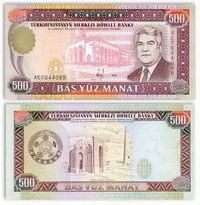Code TMT | Symbol T | |
 | ||
1/100 tenge (teňňe (Turkmen)) Plural The language(s) of this currency does not have a morphological plural distinction. Banknotes 1, 5, 10, 20, 50, 100, 500 manat Coins 1, 2, 5, 10, 20, 50 tenge, 1, 2 manat | ||
The manat is the currency of Turkmenistan. It was introduced on 1 November 1993, replacing the Russian ruble at a rate of 1 manat = 500 rubles. The ISO 4217 code was TMM, and the manat was subdivided into 100 tenge. The abbreviation m is sometimes used, e.g., 25 000 m is twenty-five thousand manat.
Contents
On January 1, 2009, the new manat was introduced with ISO 4217 code TMT at the rate of 5000 old manat to 1 new manat.
Etymology
The word "manat" is borrowed from the Russian word "монета" "moneta" meaning "coin". Likewise, 'manat' was the name of the Soviet ruble in both Azeri and Turkmen.
Coins
In 1993, coins were introduced in denominations of 1, 5, 10, 20 and 50 tenge. The 1, 5 and 10 tenge were struck in copper-plated-steel, with the higher denominations in nickel-plated-steel. This first series of coins was short lived as their metal value soon became worth more than their actual face value. After a period of high inflation, new coins of 500 and 1,000 manat were introduced in 1999. All coins of this period had to depict a picture of the president by law.
During the monetary reform of 2009, new coins of 1, 2, 5, 10, 20 and 50 tenge were issued with bimetallic 1 and 2 manats following in 2010. The 1, 2, and 5 tenge are nickel-plated steel while the 10, 20, and 50 tenge are made of brass. Instead of depicting the current head of state the coins feature a map of Turkmenistan with the Independence Tower superimposed in front of it. All circulating coins of Turkmenistan have been minted by the Royal Mint.
